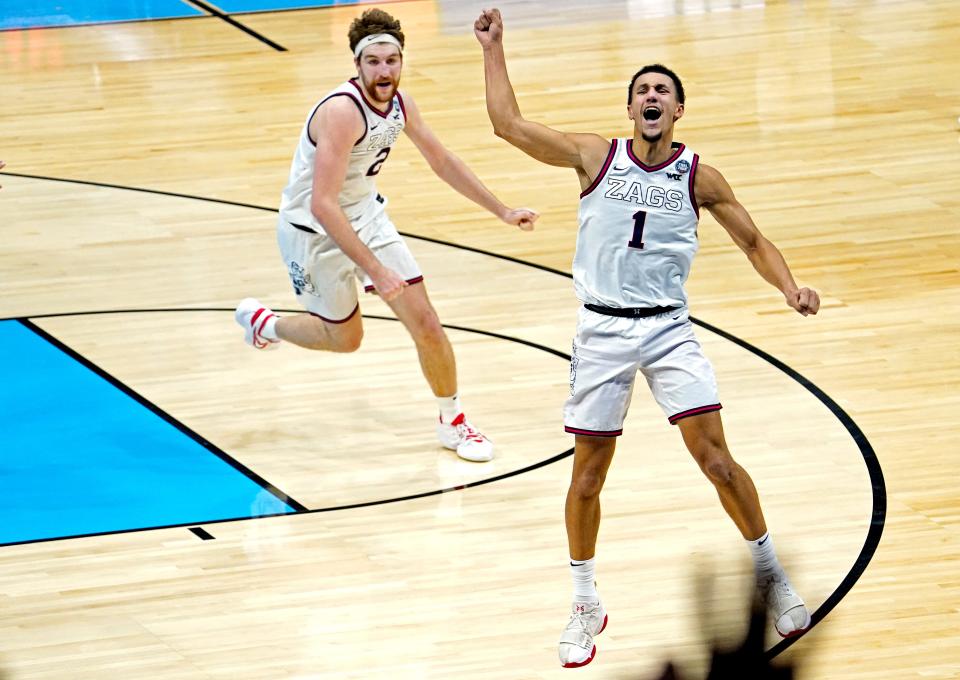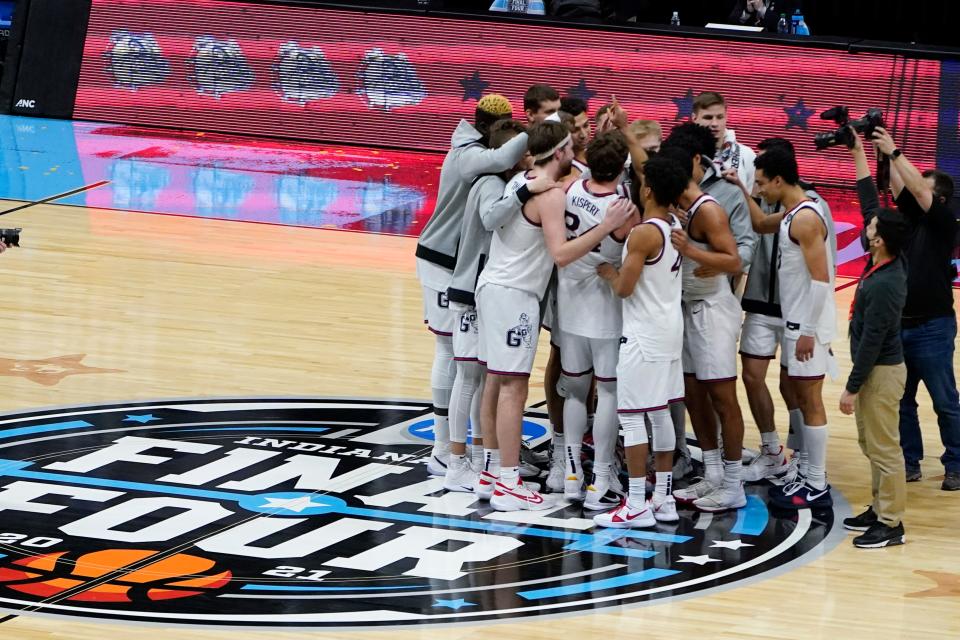Eight reasons this men’s NCAA Tournament has been best ever
INDIANAPOLIS — The cancelation of the 2020 men’s NCAA Tournament put life into perspective for college basketball players, coaches and fans. The COVID-19 pandemic-stricken reality and health and safety of the nation took precedence. That didn’t mean that there wasn’t heartbreak. Gonzaga coach Mark Few said the loss of March Madness was “traumatizing” for his players.
Over a year later, the 2021 NCAA Tournament has been played — minus Monday’s national championship game between Baylor and Gonzaga.
It’s undoubtedly been a March Madness to remember. And that’s not just because college hoops fans missed all the bracket-busting mayhem last year. It’s been historically epic.
A look at eight reasons this year’s NCAA Tournament has been arguably the best ever:
Ahem, that Final Four thriller
UCLA's near-upset of No. 1 Gonzaga was the thrill ride that will go down in the history books. Jalen Suggs' buzzer-beating banked three-pointer in overtime will be the highlight of the One Shining Moment montage. But it was the entire game that turned out to be an unexpected masterpiece, from a controversial charge call to force the first overtime to the No. 11 seeded Bruins rising to the occasion against an undefeated Goliath in the Zags.
"What a great college basketball game," Few said after the win. "And to do it on the biggest stage is just awesome. I know we had a lucky half-courter at the end. But both teams battled, battled and dug as deep, I think, as they could."
His national championship opponent concurred. "Everyone on the 8th floor of the hotel (erupted). That's what makes it March Madness," Baylor coach Scott Drew said. "We'll be talking about that shot for 25-40 years. Just the raw emotion involved, it's what makes March Madness so special."

Record upsets
The tournament’s first two weekends spelled a historic number of upsets, with the total seed count of the Sweet 16 at 94 — shattering the previous record of 89 in 1986 — with four seeds No. 11 or higher in the second weekend for the first time. Whether it was No. 15 seed Oral Roberts’ first-round shocker of No. 2 Ohio State or No. 8 Loyola Chicago’s stunner of national title contender No. 1 Illinois in the round of 32, this year’s Big Dance gave us some of the biggest wow moments in March Madness history. An argument can be made that the NCAA selection committee’s seeding wasn’t the same barometer as in years’ past because of mass postponements, interruptions and shrunken fan attendance due to COVID-19 throughout 2020-21. But the excitement was there, nonetheless.
“It’s been so dramatic, so emotional,” longtime ESPN college basketball analyst Dick Vitale told USA TODAY Sports. “Just the fact that we got a tournament when it seemed like it would get shut down earlier in the season (due to COVID-19 uncertainty), and now it’s one of the best we’ve seen.
“College basketball has always had the drama and unbelievable emotion and passion for three weeks that doesn’t compare to any sporting event. Then things were definitely up a notch a year after missing it from the pandemic.”

The missed inspiration of a Cinderella
That feeling of a Cinderella — the giant-slaying mid-major that plays with a shock-the-world swagger all game to become the tournament’s darling — surely was missed. We saw it with No. 13 seed North Texas over No. 4 Purdue and No. 14 Abilene Christian over No. 3 Texas in the first round. The most enthralling came when Oral Roberts became just the second No. 15 seed to reach the Sweet 16. The Golden Eagles were a rimmed-out Max Abmas three-pointer from becoming the first No. 15 seed to get into the Elite Eight. Oral Roberts coach Paul Mills summed up what a bracket-buster can mean to fans and how the sport can inspire.
“I’ve gotten emails and letters and text messages from people all over the world, and I’ll tell you what I believe the game of basketball does, when you’re cheering for a team that ends up winning, is it brings joy, right?” Mills said after his team’s Sweet 16 loss to Arkansas.
“... The ones who always grab me are the little kids and the people who are in the hospitals, and they say, ‘Man, I was having a bad day, and then I watched your guys fight, and because of that, it put a smile on my face. The next day I had an extra jump in my step, and I was a little bit quicker in order to do things.’ I think that’s what sports provide, and you can lose sight of that, that’s what’s happening here, who you are internally is going to get on display externally.”
Fandom illuminated on TVs (and in an Indiana bubble)
Filling out an NCAA Tournament bracket this year was a cathartic experience for fans who look forward to office pools and seeing their favorite team in a pool of 68 in a single-elimination extravaganza.
“I think missing March Madness last year helped us appreciate this year,” said Stephen Smith, 37, a Baylor fan from Waco, Texas. Fans were able to watch the tournament at venues throughout the Indianapolis area in a limited capacity because of COVID-19 restrictions, but the TV-focused spectacle delivered its typical product of enthralling action. And for those who did see it in person, it was a reminder of normalcy.
“This year’s tournament is one of the best because you don’t realize what you’re missing until it’s gone,” Marcey Smith, 36, said. “Then to have it back and all these upsets, all these awesome story lines, it’s a sports fan’s dream come true after a nightmare last year.”
The Pac-12 > Big Ten
One of the most exciting components of the tournament is that season-long narratives can be rewritten and opportunity can be seized by teams that play with determination. Such was the case this year for the Big Ten and Pac-12 conferences. The Big Ten had a historically underachieving tournament, with four league members seeded either first or second on Selection Sunday (the first time a conference was slotted into half of the top eight positions). Yet only No. 1 seed Michigan made it out of the second round. The other eight Big Ten teams were done after the first weekend.
The Pac-12, meanwhile, finished 13-5 after sending three teams — No. 12 Oregon State and No. 6 Southern California, along with Final Four finisher UCLA — to the Elite Eight. Much can be said about how the Pac-12 was underrated and the Big Ten overrated. Or we could chalk it up to inspired basketball and the inevitability of unfavorable matchups (which always happen in the NCAAs) paving the way for the Big Ten’s demise. This year, the tournament's annual surprise factor was encapsulated by these conferences.
What blue-bloods?
Who needs them? The Pac-12’s lone blue-blood, UCLA, hardly played the part going from First Four to Final Four as an upstart No. 11 seed under coach Mick Cronin. The Bruins played with a chip on their shoulder reminiscent of a counted-out team that no one believed in as opposed to a program that has 11 national title banners hanging in its rafters. Meanwhile, Duke and Kentucky missed the cut this year for the first time since 1976, with the Blue Devils a bubble team and Kentucky not even close. Kansas was upset in the second round by Southern California (another Pac-12 school) despite being a No. 3 seed. And North Carolina bowed out in a first-round loss to Wisconsin.
While a narrative heading into March Madness was how the tournament would not be the same without the signature programs, the lack of blue-blood success actually opened the door for more unpredictability and excitement. As much as fans remember a Christian Laettner buzzer-beater in 1992 or Kentucky frequenting the Final Four, seeing a more wide-open field with new kingpins helped bolster this tournament's appeal.
“It’s the unknown,” Vitale said. “People who are not die-hard basketball fans can get into this and they don’t need to know the top teams. That’s what makes it March Madness.”

Two super teams in an epic Final Four
Baylor and Gonzaga are playing for more than their first national championships. They were favorites to win it all in 2020, too, and used the extra year to morph into super teams in 2021. While this isn’t the same motivational force that Virginia used in 2019 to win the title after getting historically bounced in the first round by a No. 16 seed, the psyche of these powerhouse teams makes for a powerful story line. Baylor All-American guard Jared Butler said the cancelation is what caused the Bears to “get the band back together” for a deep March run. And Gonzaga senior Corey Kispert said “this March Madness is a buildup over two years” and that the undefeated Zags (31-0) get to “play for some of the guys on last year’s team that don’t get this chance.” They play for the national championship Monday (9 p.m. ET, CBS).
Spotlight on gender inequality
The return of March Madness also unveiled ongoing patterns that need to be corrected. The disparity between the men’s and women’s tournaments was highlighted before first tip, with inequities ranging from weight rooms, food, player gifts and branding. This reflected negatively on the NCAA and led president Mark Emmert to admit he “dropped the ball.” He has asked for an independent review and vowed change.
Follow college basketball reporter Scott Gleeson on Twitter @ScottMGleeson
This article originally appeared on USA TODAY: March Madness: Eight reasons men's NCAA Tournament was best ever

